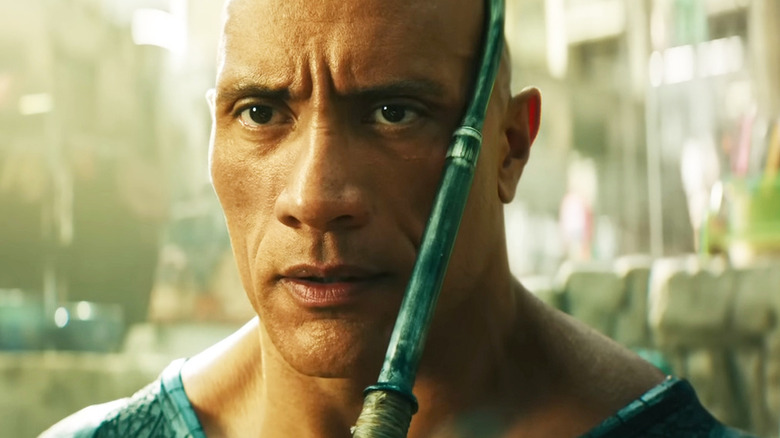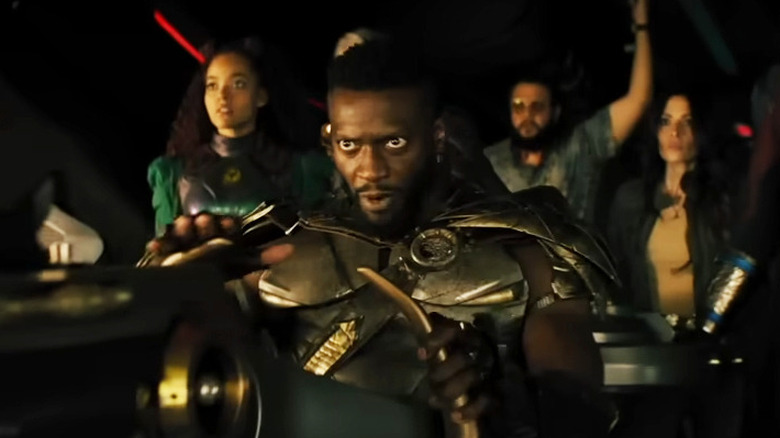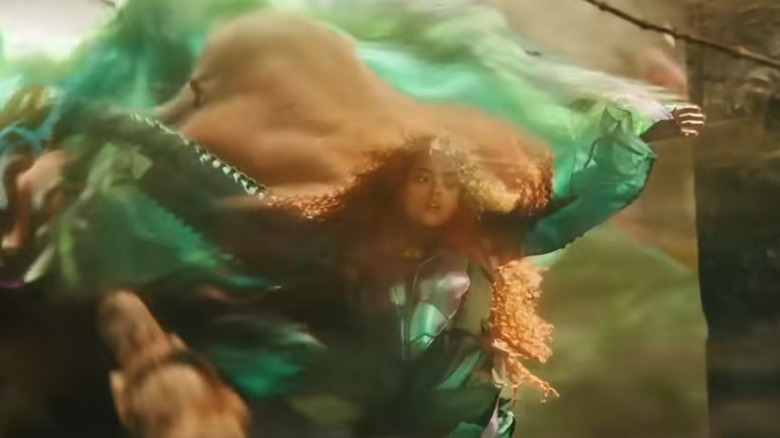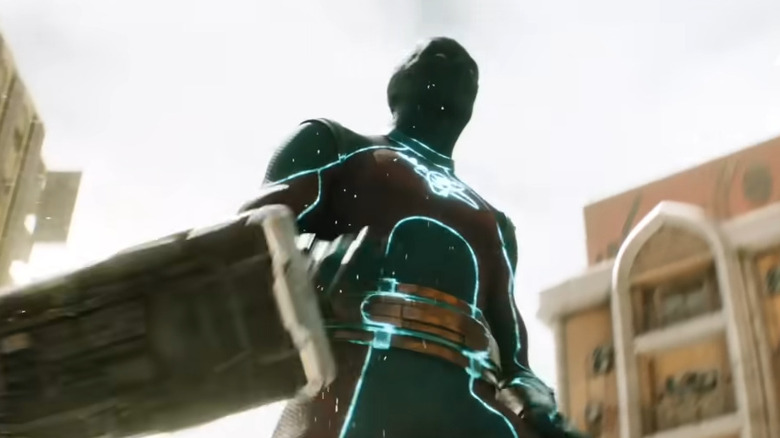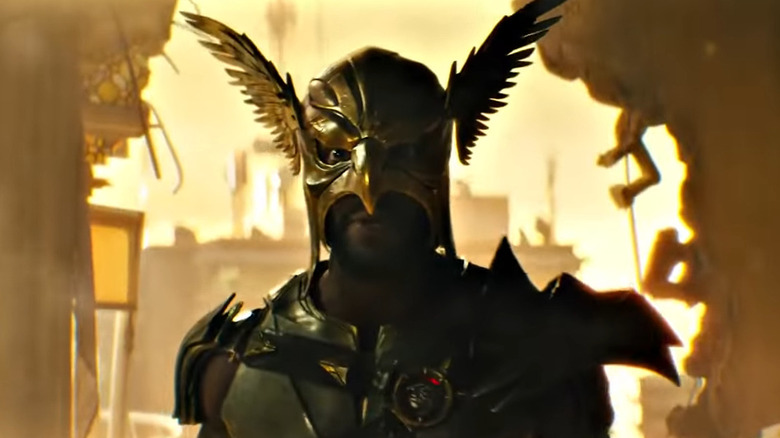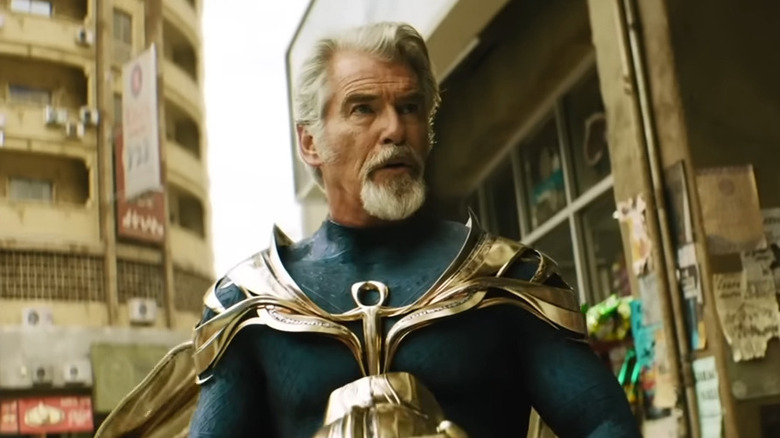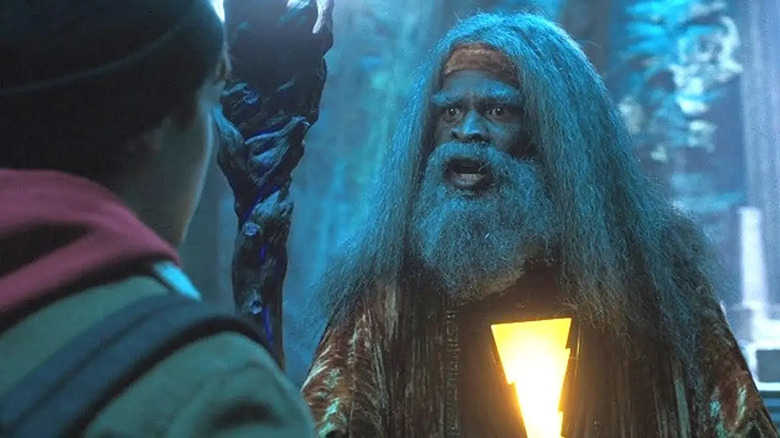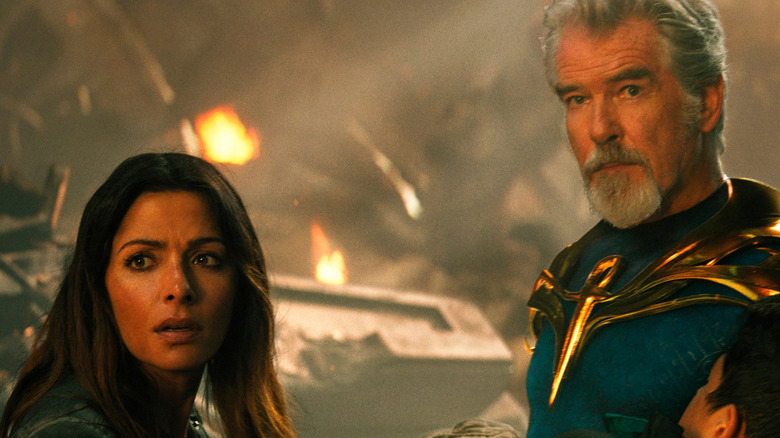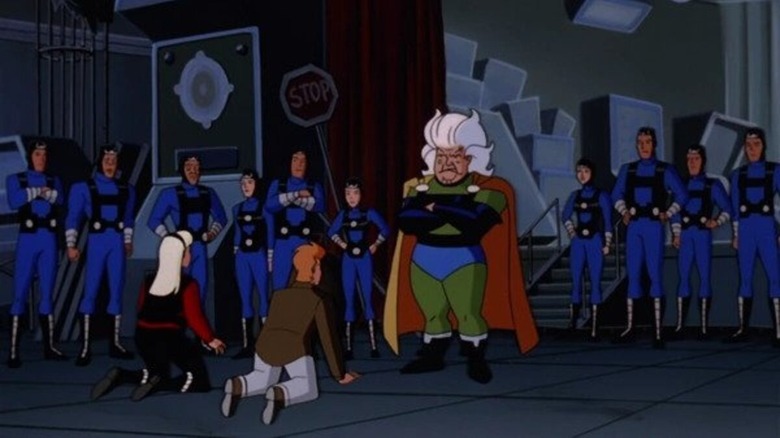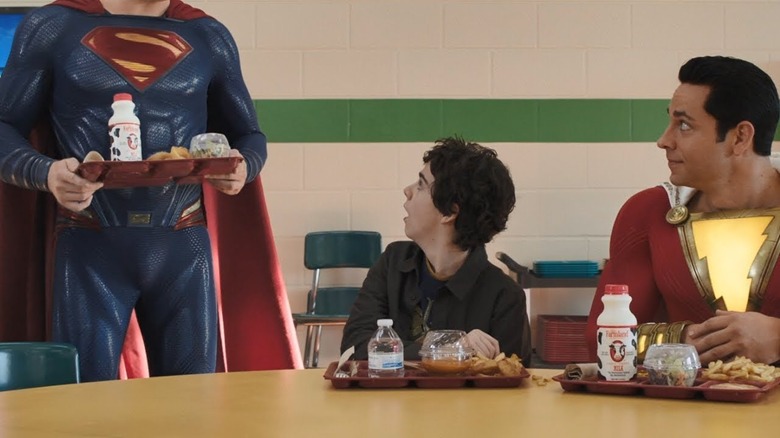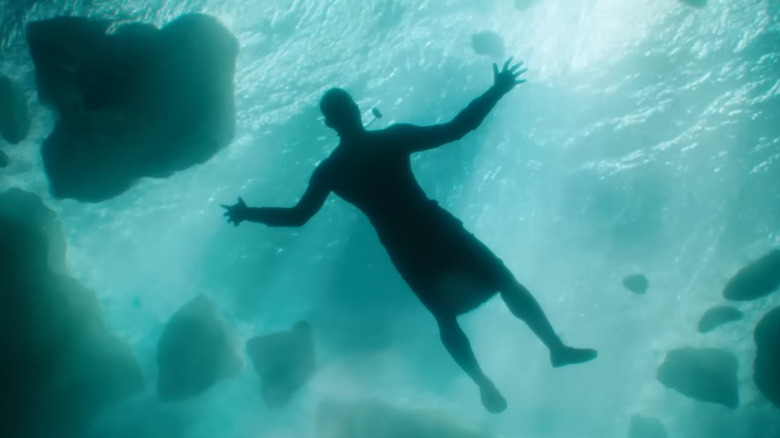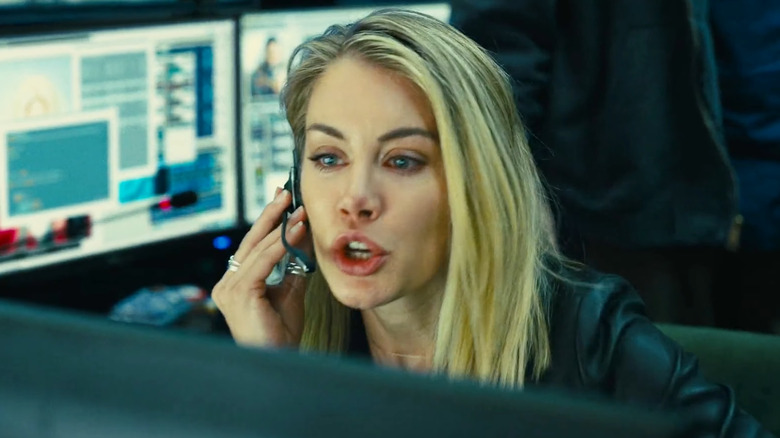Easter Eggs You Missed In Black Adam
"Black Adam," a passion project for its star, Dwayne "The Rock" Johnson, has been in development since 2007. Since that time, superhero movies have gone from being an occasional feature of the cinematic landscape to absolutely dominating it. The DCEU has grown into a rich and dynamic world, many feature films (and a television series) deep. But as much as fans have been salivating to see Johnson embody a role that feels tailor-made for his physique, charisma, and drive, they've also been itching to see how Black Adam could exist in the fictional universe we've now spent so much time in.
The talented cast and crew of "Black Adam" worked tirelessly to make the movie its own endeavor, capable of entertaining audience members with no prior knowledge of the DC films it's tethered to. But they also used it as an opportunity to expand the borders of the DCEU. They accomplished this by introducing new characters and concepts outright, but also by layering in plenty of Easter eggs that imply further world-building, tease the DCEU's future, and quickly wink at the source material. If you overlooked these details, nods, and references because you were so in awe of watching the hierarchy of power in the DC universe shift forever, we're here to catch you up. These are the Easter eggs you missed in "Black Adam."
Spoilers ahead for "Black Adam"
Introducing the Justice Society
The Justice Society of America has appeared or been alluded to in many different animated series and live-action shows — CW series "Stargirl" even features two different incarnations of the team. But "Black Adam" sees the JSA debut in the DCEU, which is an entirely different tier of recognition. Referred to as the Justice Society, this group is presented as a peace-keeping organization, and is implied to have many more members than the four who figure in this film's mission. While said mission easily could have been a job for Amanda Waller's infamous Task Force X or an opportunity to use the better-known Justice League, bringing the JSA to the big screen has a power all its own — one that's easy to overlook if you haven't got the necessary comics knowledge.
For most of his fictional history, Black Adam has been a villain. But things changed in the pages of t he 1999 "JSA" comic series. Here, Adam undergoes an evolution and a change of heart that realigns him as an edgy antihero. Much of that progression comes from his proximity to the JSA, here comprised of elder heroes who have been fighting the good fight since the 1940s. They offer Adam a sense of kinship, as he is similarly displaced in time, only more so. Thus, putting the JSA in Black Adam's first feature film, rather than another super team, strikes a meaningful note for fans of the comics.
Cyclone's troubled beginnings
"Black Adam" is a film that moves a bit too quickly to muster much time for delving into its supporting players' backstories. But there are a handful of nods to comics lore that eagle-eyed fans should recognize immediately. One especially vivid example is the scene where Atom Smasher (Noah Centineo) tells Cyclone (Quintessa Swindell) how impressed he is, now that he's seen her superpowers in action. He explains that his powers are hereditary, and expresses curiosity about the nanobot-driven aspects of her own wind-based abilities. She tells him she was kidnapped by an evil scientist as a child, who performed experiments on her. This dreadful experience left her with the ability to control the wind.
Cyclone doesn't refer to the sinister perpetrator by name, but diehard fans will know exactly who she means. In the pages of DC comics, Cyclone, aka Maxine Hunkel, gets her powers from being experimented on by Professor T.O. Morrow, the same mad scientist who created the Red Tornado. Morrow has been a stable villain in the DC universe for years, frequently crossing paths with the JSA and the Justice League. He's also appeared in multiple small-screen DC adaptations, including "Supergirl" and "Young Justice." But he'd never appeared in a live-action movie before "Black Adam" hit theaters. Perhaps we'll see more of this malicious madman in future DECU outings — and, hopefully, Cyclone as well.
Keeping it in the family
"Black Adam" makes room for a number of delightful JSA-related cameos, but one related to Atom Smasher's heroic legacy is particularly enjoyable. On the ride over to the mission debrief, Atom Smasher is on a video call with Al Pratt, the original Atom, played wonderfully by Henry Winkler. "Uncle Al" tells him to be careful with the suit, as it's a very special family heirloom.
In the comics, Albert Pratt is godfather to Atom Smasher, whose real name is Al Rothstein. The film seems to have simplified their connection by making him an elderly relative instead, sidestepping the need to address the complexity of his comic book origins (and how many decades now separate the modern day and the 1940s). The 1999 "JSA" comic series, a huge influence on "Black Adam" in many ways, is big on introducing second and third generation heroes, while keeping the veterans around to show the rookies a thing or two. Seeing Al Pratt referenced on the silver screen is a wonderful way to continue that legacy and indicate the character's deep roots. Any future cinematic appearances from the Justice Society would do well to follow in this cameo's footsteps, if only to bring in such excellent character actors. Even if we don't get Alan Scott's Green Lantern or Jay Garrick's Flash, we definitely need more Henry Winkler in the DCEU.
Heavy metal
In "Black Adam," Hawkman (Aldis Hodge) initially appears to be the Justice Society's answer to Batman. He's rich, lives in a big mansion, has the gruff leader vibes covered, and, crucially, lacks bodily superpowers. It's not until we see the science fictional ship he and the team travel in that we get a vivid glimpse of what makes him extraordinary. The entire ship, as he tells Cyclone, is made of Nth metal. This highly advanced and mega-powerful substance also makes up his armor, wings, and mace. The latter object is a huge and devastating creation that transforms into other weapons throughout the film, most notably an axe.
In the comics, Nth metal originates on Thanagar, the planet some iterations of Hawkman come from. This film's Hawkman, whose secret identity is Carter Hall, doesn't appear to be one of the Hawkmen who is actually Thanagarian. But by openly referencing the storied metal, "Black Adam" hints at a cosmic side to the DCEU, which reaches into the far corners of the galaxy. Mentioning Nth metal also brings the darkly magical side of the DC universe to the fore: The fabled substance plays a major role in the 2017 "Dark Nights: Metal" comic event, which introduces the arcane Dark Multiverse. It remains to be seen how the DCEU might incorporate Nth's metal's fascinating history, but this Easter egg definitely whets fans' appetites for more.
The Helmet of Fate
There's a moment that happens early in "Black Adam," where Kent Nelson, aka Doctor Fate (Pierce Brosnan), leaves his helmet out on the Justice Society's ship. Atom Smasher tries to touch it, and Hawkman tells him not to. He explains that it's otherworldly, and only works for the wearer it has chosen to be its host. Tragically, Doctor Fate later sacrifices himself to buy the team some time against Sabbac (Marwan Kenzari), which allows Black Adam to break free from his underwater prison. Hawkman, a close friend and ally of Fate's, is able to temporarily use the helmet at a key point in the battle, suggesting the helmet trusts him the same way it did Nelson. But when that moment comes to an end, the helmet disappears entirely.
In the comics, the Helmet of Fate (sometimes known as the Helmet of Nabu) has had many hosts over the years. When Nelson dies and it shuffles away, comics fans know it's probably off to find his successor. Doctor Fate is sort of like DC's equivalent to Marvel's Sorcerer Supreme: It's a hugely powerful magical title that demands nearly everything from those who bear it. Kent Nelson is probably the most noteworthy Doctor Fate, but he's definitely not the only one. The DCEU is probably unlikely to take things back to the '90s and bring angst-ridden Jared Stevens to the big screen, but they might introduce audiences to Khalid Nassour, a young Egyptian-American man from New York City who is the comics' current Doctor Fate.
Off to see the wizard
"Black Adam" goes out of its way to disassociate itself from the 2019 "Shazam!" film that precedes it. This is likely due to the two outings' diametrically opposed tones: "Shazam!" is light and airy in a way "Black Adam" just can't afford to be. But that doesn't stop the connections between these two movies from bubbling forth.
In the film's many flashbacks to Adam's origins — meted out over the course of the movie in exponentially more revealing bursts — actor Djimon Hounsou appears as the wizard Shazam. This powerful magic-user plays an important part in "Shazam!": He's the enigmatic figure who gives Billy Batson his superpowers. He doesn't get any dialogue or more than a passing glance in "Black Adam," but his unmistakable visage tethers the film to the larger DCEU, and Adam himself to the universe's most ancient entities.
Adam's flashback sequences also explore the central tragedy of his cinematic origin. He himself was not Shazam's chosen champion — his son was. Knowing he could not kill the boy, the vicious King Anh-Kot slew his family instead. Adam's son gave his father the power of Shazam in an effort to save his life. It worked, which meant Adam was forced to watch the king's men brutally murder his suddenly mortal son. This is a tragic and moving subversion of Black Adam's modern comics origin: There, he killed the boy to seize his powers for himself.
The secrets of Isis
For much of "Black Adam," Adrianna Tomaz (Sarah Shahi) and her son Amon (Bodhi Sabongui) represent the human element within a fantastical world of gods, wizards, and superheroes. Their struggle and yearning for Kahndaq to be free grounds all the action and intrigue in something decidedly Earth-bound. But in the comics, these two characters are far from ordinary bystanders.
Writer and DC universe architect Geoff Johns has contributed more to the Black Adam mythos in the last 20 years than any other comics scribe. One of the biggest arcs he penned for the character takes place in 2006's "52" series. In this comic, Black Adam creates his own dark version of the Marvel Family, turning Adrianna and Amon Tomaz into Isis and Osiris. These two superpowered figures are fueled by Adam's own energy the way Mary Marvel and Captain Marvel Jr. are fueled by Billy Batson's.
Isis, as some may recognize, is also a callback to "The Secrets of Isis," a 1975 television series that formed the latter half of "The Shazam/Isis Hour." The 1974 "Shazam!" series, which formed the other half, was actually the first live-action adaption of the Captain Marvel mythos. Though Isis later appeared in "Smallville" and "Legends of Tomorrow," "Black Adam" marks her first appearance in the DCEU, albeit in a de-powered state.
The long history of Intergang
"Black Adam" is a film with loosely anti-colonial themes. It presents the fictional nation of Kahndaq as a Middle Eastern country that has been oppressed and exploited by foreign powers for much of its existence. In the present day, Kahndaq is run by Intergang, who seem to be a tech-obsessed band of mercenaries in search of the Crown of Sabbac. Though they're certainly important, the film shifts gears away from them to primarily focus on Ishmael (Marwan Kenzari) and his connection to the ancient King Anh-Kot.
Uniquely, sharp-eyed fans might recognize Intergang from "Superman: The Animated Series" before they recall the group's comics history. In that cartoon, they're frequently featured as antagonists to the Man of Steel. This animated adaptation keeps them largely in line with the comics, where they're a hugely powerful criminal organization run something like a corporation. They also boast seriously advanced tech and sci-fi weaponry, originating from Apokolips. Though they're a constant thorn in the big blue boy scout's side, Intergang is often presented as something of an appetizer to an inevitable Darkseid appearance.
As the Darkseid-teasing ending of "Zack Snyder's Justice League" isn't treated as DCEU canon, it's unlikely that Intergang is being used in "Black Adam" as a similar indication of upcoming Fourth World adventures. They're pretty much run-of-the-mill boogeymen who become fodder for Adam's vengeful carnage. But who knows? Maybe we'll see more of them in the future, complete with Apokoliptian weaponry.
In-universe fanboys
Like "Shazam!" before it, "Black Adam" acknowledges superheroes' in-world celebrity and pop culture presence. In the former movie, Billy Batson (Zachary Levi, Asher Angel) and Freddy Freeman (Jack Dylan Grazer) are aware of Superman and his Justice League compatriots — Freddy even owns a well-loved selection of hero-themed t-shirts. In "Black Adam," Amon acts as the resident fanboy. When we first meet him at an Intergang checkpoint, we see a stack of comics fall out of his backpack. Then we see his bedroom, which is absolutely plastered with superhero posters. Black Adam wakes up within this room and inadvertently destroys a poster bearing Superman's image with his lightning powers, foreshadowing a cataclysmic showdown between two titans of the DC universe.
Beyond the Man of Steel, Amon has also tacked up posters of Aquaman and the Flash. The kid further cements his status as the movie's resident geek by giving Black Adam advice about how to be a hero. According to Amon, Adam should go about developing a catch phrase, a more modern nickname, and a cape. This portrayal is a loving nod to ink-and-paper superhero fans everywhere, famed for their comprehensive knowledge of hero tropes and towering stacks of comic books. Many audience members see their own young selves in Amon, and perhaps recall their own poster-filled bedrooms.
An underwater prison
The DC universe is home to a number of high-security institutions meant to keep the bad guys safely contained. Gotham City has the infamous Arkham Asylum and Blackgate Penitentiary. Metropolis has Stryker's Island. Central City's got Iron Heights. Right outside of St. Roch, Hawkman's stomping grounds, lies Belle Reve, the prison Amanda Waller (Viola Davis) farms future Task Force X operatives from.
"Black Adam" reveals another one of Waller's high-priced cages. When she tasks the Justice Society with capturing and detaining Adam, Hawkman tells her that if she's got a cell that can hold him, they'll put him there. This cell ends up being an unnamed facility hidden in an underwater base. When Adam eventually makes his way there in his de-powered state, we see that several other high-powered individuals are locked up in close proximity, suggesting this is where Waller stashes the heavy-hitters unsuitable for use as cannon fodder on suicide missions.
Though unnamed, this place feels a lot like the Aquarium, an underwater prison that occasionally shows up in Aquaman-centric comics. It's hard to imagine the Atlanteans of the DCEU working with Waller on this, unless a dramatic change has occurred off-screen. But who knows? Amanda Waller is renowned for her ability to make the impossible into cold, hard reality.
A familiar face
When the Justice Society brings Adam to the deep sea penitentiary for holding, there's a familiar face lurking in the crowd. This is Emilia Harcourt (Jennifer Holland), an A.R.G.U.S. agent from "The Suicide Squad." Last seen in Season 1 of "Peacemaker," she gets less than a minute of screen time to interact with our heroes in "Black Adam." But within that brief cameo, she's able to amply display the no-nonsense attitude that makes her so much fun.
Amanda Waller is fantastic as the DCEU's closest thing to Nick Fury. But Fury doesn't work alone — he has agents like Phil Coulson and Maria Hill to support him. Emilia Harcourt plays a similar role, and does so wonderfully. Her brief presence is also a particularly fun treat for fans of "Peacemaker," thus far the DCEU's only in-continuity foray into serialized television. Here's hoping this is the start of more overlap between those mediums.
